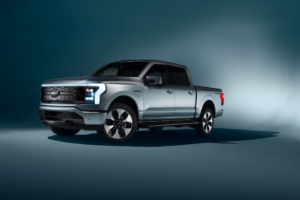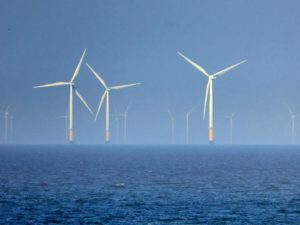May 31, 2021 – Volume 23, Issue 5
In This Issue
-
Flanigan’s Eco-Logic: Dinner with Amory
- America’s First Big Offshore Wind Project
- Microgrids 1.6: Giving Batteries a Day Job!
-
Ford’s Radical EV: The Lightning
- Montreal Hosts the World’s Largest Rooftop Farm
-
Filtering Air and Oceans
-
Regional Wind Diversity
- The NetPositive Updates

Flanigan’s Eco-Logic: Dinner with Amory
Just back from ten days in the mountains of Colorado, the Roaring Fork Valley to be more specific… Old Snowmass to be precise. Actually, that’s Snowmass, but the locals throw in the “Old” so it’s not confused with Snowmass Village, the ski area resort complex.
My first night, daughters Sierra and Skye organized a mini-reunion of my Rocky Mountain Institute colleagues from the late 1980s… Lovins, Sardinsky, and Heede. Others too like Munk and Childs. Perfect temperature on the deck… the magnificence of spring in the Rockies.
Dinner two nights later, Amory, myself, and Sierra and Skye. They’ve known Amory since they were born. Off to Café Bernard in Basalt. Judy was out of town and Amory was hungry. We think the meal really fulfilled him! Between calamari and our entrees and dessert, we had more of a chance to reminisce and catch up on Amory’s consulting, RMI happenings, and new developments in the valley. At one point, Amory turned to me and pointing to my jacket said, “What does EcoMotion do?” I replied:
“Once upon a time, not too, too long ago, there was a very curious man… a high primate you would say. He charted a distinctly different utility approach and formed a movement that ultimately transformed the electric utility industry worldwide. Instead of building more and more coal plants, clearly polluting, why not try to use less plants.” Back then, Amory described that nuclear fission was like cutting butter with a chainsaw. Overkill. He thought, why not try a different approach? He called it the soft energy path… the road not taken.
“Where did this come from?” This vision. Amory explained that you don’t always have to add. You can subtract. That’s true for power plants and a good deal of engineering. The soft energy path is based on energy efficiency, subtracting from the gross load utilities have been obligated to serve. And it’s easier to subtract than to add, it just comes in smaller chunks! Efficiency is the art of using precise amounts of energy to get the job done. And now the net can be generated with renewable power, distributed throughout our society in benign configurations.
The curious man’s energy philosophy was published in the Journal of Foreign Affairs. Soon thereafter, the very curious and unquestionably smart man developed a following. I was part of it. He went to the White House to explain the soft path to President Jimmy Carter. He married a dynamo… literally and figuratively a Hunter. He wore a cowboy hat, but never seemed much like a cowboy. Instead of wrangling cattle, he created a generation of energy wonks who followed his teachings. He created a think tank high in the Rockies. Some alumni became lighting designers; others installed solar panels. One glommed on to biophilic design; others a lifetime of carbon accounting and policy designs.
Another night, I have dinner with the general manager of Holy Cross Energy (HCE), his board chair, and chief engineer. HCE is the local cooperative. Bryan Hanegan explained his utility’s progressive stance, its penchant for local distributed resources, his strategy for partnerships with his customers for generation and storage. HCE is now 50% green and on a path to net zero. His Chief Engineer, Chris Bildy, had a sparkle in his eye, working to answer my questions about hooking up mobile generators and vehicle-to-grid configurations. Chris was concise and targeted: “It’s all about interconnection.” HCE will work hard to make interconnection easy for its members. Refreshing.
While California utilities limit onsite solar production to site usage, HCE pays 10 cents per kilowatt-hour – more than double the California rate for overproduction – to encourage net positive homes. This is part of the new age utility that Amory envisioned. HCE is welcoming distributed generation, relying on it, in fact. By the end of the evening, I’d signed up for two Tesla Power Walls at our Snowmass home. Their first priority is cycling as orchestrated by Holy Cross, but in the event of an outage… the stored energy is all mine!
Amory’s early calling card in the electric utility industry was the term “negawatts.” These are the watts you don’t need thanks to energy efficiency (technologies) and conservation (behaviors). Over dinner, Amory was talking about electric aviation, and generating 8x efficiency gains doing so. He’s consulting for revolutionary car companies. He inspired me with his powerful notions of “nega-steel” and “nega-concrete.” By designing lighter buildings, you need lots less steel and cement, finding a win-win-win between structural integrity, cost savings, and environmental savings.
Spending time with my energy guru, absorbing Amory’s talk about innovative technologies, was our great pleasure. He is a treasure in wit and energy. That night, he again gave us a sense of rational possibilities ahead. He makes thinking out of the box seem only logical! One thing is for sure, the curious man in the mountains has not lost an ounce of his curiosity. Good news, that is the root of his visions.
Quote of the Week
“My hope is that the F-150 Lightning will play as big a role as the Tesla Model S in revolutionizing the auto industry. I look forward to backup power stations being built into all EVs and plug-in hybrids.”
Alex Wilson, Founder and Executive Editor
Environmental Building News
“California, as we all know, has a world class offshore wind resource, and it can play a major role in helping to accelerate California’s and the nation’s transition to clean energy.”
America’s First Big Offshore Wind Project

Image Courtesy of The Vineyard Gazette
Yes, it’s America’s first utility-scale wind farm… approved by the Biden Administration this month with construction expected to begin this summer. The Vineyard Wind project will involve 84 turbines in the Atlantic Ocean, approximately 12 miles off the coast of Martha’s Vineyard. The farm will have a capacity of 800 MW, then its power will travel via cables buried six feet below the ocean floor to Cape Cod. Vineyard Wind expects to deliver power by 2023.
This is a big step. Right now, there are only two offshore wind farms in the United States. They produce a rather paltry 42 MW. The Block Island Wind Farm is situated 3.8 miles southeast of Block Island in Rhode Island. The 30 MW, five-turbine farm began commercial operation in 2016. The 12 MW Coastal Virginia Offshore Wind project is 27 miles offshore in the Hampton Roads region of Virginia. It is the first utility-owned wind farm (Dominion Energy), and the first to be built in federal waters.
There are also a dozen other offshore wind projects under federal review. The U.S. Interior Department has estimated that by the end of the decade, there could be 2,000 turbines along the East Coast from Massachusetts to North Carolina. The Biden Administration has pledged to build 30,000 MW of offshore wind in the United States by 2030. Efforts will include fast-tracking for permits and $3 billion in loan guarantees for offshore wind projects and investments in upgrades to ports to support wind turbine construction.
Offshore wind is not without challenges: There is opposition from commercial fishing groups and coastal landowners; there are concerns about the effects on marine life. One commercial fishing group – the Responsible Offshore Development Alliance… worries that its members’ boats and trawlers will have difficulty navigating around the turbines. And this, they say, could affect the catch.
Let’s go west: On May 26th, California Governor Gavin Newsom signed an agreement with Interior Secretary Deb Haaland and other Biden Administration officials to open up the West Coast for offshore wind development. Offshore wind is a strong means for California to achieve its climate goals while providing jobs. The announced lease will open areas to support up to 4.6 GW of offshore wind capacity, enough to power 1.6 million homes. The Bureau of Ocean Management intends to offer a lease sale as early as 2022 for a 399-square mile area of the Central Coast northwest of Morro Bay, and a separate area on the North Coast. Floating wind turbines are planned for 95% of the proposed lease area, 20 – 30 miles offshore. As part of the California Comeback Plan, Newsom has proposed $20 million in funding to support offshore wind development.
Microgrids 1.6: Giving Batteries a Day Job!
 This sixth article on microgrids works an angle: The idea is to give expensive batteries a day job so that they earn their keep, so that they earn revenues. Solar earns money… so should batteries. Right?
This sixth article on microgrids works an angle: The idea is to give expensive batteries a day job so that they earn their keep, so that they earn revenues. Solar earns money… so should batteries. Right?
EcoMotion is currently working for Clean Power Alliance and its member agencies to identify facilities for energy resilience. Each member agency was able to nominate up to five sites for our analysis. Further, our charge is to model solar + storage + energy resilience such that the facilities are operable during short-term and prolonged outages. These are carbon-free microgrids and our goal and challenge is to finance the diverse portfolio of projects at parity.
Let’s unpack that, starting with a single site. We determine its total load during normal use, and then its critical loads—the smaller portion that is essential to operate during an emergency. We then size solar to cover the annual load, and storage to provide power for critical loads. We want enough storage to ride through the night in “Battery mode.” Maximum conservation. Then solar will recharge the batteries the next day.
The obstacle is that batteries are expensive; they tax the balance sheet. Thus wW\e want the batteries to help pay for themselves. That’s why we say, “Give the batteries a day job.”
So what does this “Day job” look like? Imagine this… we are going to take the majority of the battery’s energy storage – say 75% of it— and put that to work. We are going to a) do energy arbitrage, and b) cut peak demand. In the future, we may be able to sell “ancillary services” to utilities… things like resource adequacy, frequency control (up and down), and power factor control.
Energy arbitrage sounds like a troubling financing scheme. In this instance, it is simple: buy and/or generate inexpensive energy, store it, and then discharge it during peak periods when energy is expensive, offsetting peak rates. It’s a basic financial play… enabled by having storage. Let’s consider an example. Let’s say that I have a building can u buy ambien in mexico served by Southern California Edison’s TOU-GS-2-E rate. That costs a whopping 62.5 cents per kWh for summer on peak power, versus 16 cents off peak. If I store the solar electricity I generate during the day when energy is cheap, and then I use it in the evening when it costs 62.5 cents (and my solar panels are no longer generating energy because it’s dark), you can see dramatic savings.
One of the most attractive policies to incentivize solar power has been a series of rates offered by California’s investor-owned utilities that raise energy charges and lower demand charges. PG&E’s A6 rate, SCE’s Option R, now E, and SDG&E’s DR rate grant customers reduced demand charges as long as their solar provides at least 15% of peak demand. After the rate switch, the demand charges plummet, providing solar economics with a nice boost.
The flip side of this benefit is that when batteries are installed with solar… batteries that are expert at picking off spikes in the load profile… the high cost of load spikes is much less dramatic. There is less “Profit” to harvest from demand-limiting activities. Perhaps this conflict in rate structures and incentives will be addressed by the CPUC’s microgrid rate design. All that said, there are still some savings to be realized by cutting peak demand.
Let’s throw out some numbers: A city hall in LA County had baseline usage of 418,803 kWh a year at a cost of $76,987. After ~210 kW of solar, the cost falls to $31,429. (Solar cut $45,558 from the power bill). We model 300 kWh of storage. Its “Day job” will earn $12,606, resulting in a net “Utility bill” of only $18,823. In this instance, solar savings are 4x storage savings… but important to project economics. Another coastal city hall uses $88,000 of power, solar saves $67,000, while storage savings are $9,000. In that instance, solar savings are 7x storage savings.
One more wrinkle: Let’s imagine that your battery, in the course of doing its day job, discharges all the energy it has stored in pursuit of maximum savings at the exact moment an unexpected outage occurs. There’s nothing in the tank, and the resiliency benefit is zero! That’s why we don’t give the entire battery a day job. We put 75% to work maximizing savings, and leave 25% untouched, always ready to power the facility during an outage. That’s our “Resiliency carve out.” If the outage is announced in advance (like a PSPS event), then the entire battery can charge up and be ready to provide resilience.
Developing cost-effective systems—systems that we aggregate and then take to market for financing—is challenging. We want a PPA rate that costs no more than these facilities paid without solar, storage, and resilience. I call it threading the needle. You need enough expensive storage assets to use and generate revenues, while leaving a carve-out for resilience. The storage savings, while a fraction of the solar savings, are important. Make sure to give your batteries a day job!
Ford’s Radical EV: The Lightning

Image Courtesy of John Roe I Car and Drive
Ford’s F-150 pick-up truck has not only been the best-selling truck in the United States for 44 years, in recent years it has been the best-selling vehicle of any type in the world. Last year, Ford sold 790,000 F-150s.
And it soon may be revolutionizing electric mobility. The all-electric, brand-new F-150 is called the Lightning. What excites me is that it provides back-up power. It is the first EV designed to be a household back-up power.
Ford earned some notoriety during and after the Great Texas Black-Out. Some of its 2021 F-150 hybrid models featured back-up power. It was perfect for job site power, tailgaters grilling burgers, keeping beer cold before ball games, and camping. Yes, you can plug your fridge, phones, and other electronic gear into the high output 120 and 240 volt plugs in the beds of these trucks. Pretty cool, and in cases, life-saving.
How does it do this? The trucks come equipped with bidirectional inverters. They can take household power and turn it into DC power to store in their batteries. Inversely, they can release DC power from their battery banks and convert it to AC power for use. The trucks have AC outlets that can be plugged into. How ideal for power on construction sites… just run an extension cord to the truck.
Fast forward… the new, all-electric Lightning trucks can provide for household energy resilience without extension cords. With the 240-volt, 80-amp Ford Charge Station Pro, plus home management system, the F-150 will automatically kick in to power your house during a power outage. Ford’s Intelligent Power Backup provides a whole house solution. At best, the trucks can power homes for up to three days. The integration of this charging station into the homes electrical system permits the charge to automatically redirect the power flow into or out of the battery when the power blinks off or back on, while safely isolating the house from the power lines to protect line workers trying to fix the grid.
The cost of the F-150 Lightning starts at $39,974. That model delivers 230 miles of range. For $49,974, one gets an extended range of 300 miles. Ford estimates 40% savings on maintenance as well. This is the working man’s truck! Ford is making a major contribution to the auto industry. Its EV solution will appeal to a different demographic than those who buy Priuses and Teslas. The Lightning may pull a significant segment of the market over to EVs.
The F-150’s body looks pretty standard, but its 563-horsepower engine can go from 0 – 60 in five seconds, making it the fastest pickup. It uses Nickel – 9 NCM batteries that are 90% nickel, 5% cobalt, and 5% manganese. The batteries are being produced in Georgia in partnership with SK Innovation which claims that the batteries offer higher energy density, longer range, and better environmental performance than lithium.
In the future, Ford intends to make the F-150 Lightning’s battery banks even more valuable. Like stationary batteries, they will not only be available for power outages, but they will be able to power homes during the day when the grid is fully functional. They may well be cycling daily to optimize on your mobility needs and the values they provide for energy arbitrage and peak demand limiting. They will buy and store inexpensive power, and then discharge when electricity rates are higher, cutting power costs and further integrating vehicle-to-grid technologies.
Montreal Hosts the World’s Largest Rooftop Farm
 A massive greenhouse atop a Montreal warehouse is now growing eggplants and tomatoes. It’s meeting the demand for locally sourced foods in the heart of Canada’s second largest city, Montreal.
A massive greenhouse atop a Montreal warehouse is now growing eggplants and tomatoes. It’s meeting the demand for locally sourced foods in the heart of Canada’s second largest city, Montreal.
The greenhouse is 160,000 square feet, the size of three football fields. Lufa Farm’s mission is to grow food where people live and in a sustainable way. It is the fourth rooftop greenhouse that Lufa has erected. This one collects and reuses rainwater.
Lufa grows 100 varieties of vegetables and herbs grown year-round in hydroponic containers lined with coconut coir and that are fed liquid nutrients. These include lettuce, cucumbers, zucchini, bok choy, celery, and sprouts. Lufa is feeding about 2% of Montreal.
Others have run with the urban rooftop farming concept. American Gotham Greens has built eight greenhouses on rooftops in New York, Chicago, and Denver. French Urban Nature is planning to open one in Paris in 2022.
Filtering Air and Oceans
Futuristic mobility? A Chinese electric vehicle brand, IM Motors, has collaborated with designers to design a car called “Airo.” It’s a compact urban electric car with a global and environmental mission: Its active filtering system on board vacuums up pollution and cleans the air. Polluted air carrying particles of various sizes of harmful chemical pass under the vehicle and into its HEPA filter.
Launched as a concept car at the 2021 Shanghai Auto Show, this adaptive and adjustable vehicle is now ready to go into production. Beyond an “air-filtering automobile,” Airo is an autonomous vehicle that has double-wide sliding doors that open into a spacious interior. Since cars are only used about 10% of the time, its designers worked to create a space which can be transformed into a lounge, a gaming pod, or a room for sleeping. Its glass roof can be made opaque creating a private bedroom space. Airo has a large screen for watching movies or sports.
Let’s now get out on the high seas… with Manta, a sea-cleaning sailboat being developed that will feed on plastic waste. Every year 8 million tons of plastic goes into the oceans. French-Swiss navigator/explorer, Yvan Bourgnon, decided to fight it. He and his team at the Ocean Cleanup Project, formed in 2016, have designed Manta, a giant, 184-foot, plastic-eating catamaran. It will use a combination of advanced sail technologies plus electric motors powered renewably.
Manta will have 500 kW of wind turbines, ~5,400 square feet of photovoltaics, and a waste-to-energy conversion unit. Manta will be able to pick up floating macro-waste and smaller debris from 4” up, and up to three feet deep. It is being designed to collect 1 – 3 tons of waste per hour. Remarkably, it will process 90 – 95% of the waste while at sea. How does this work? Waste collecting conveyors will bring the waste on board. After passing through a waste sorting unit, the waste will then fuel the waste-to-energy conversion unit. It will convert the waste directly into electricity through pyrolysis, with hardly any pollutants or CO2.
The Manta is slated for completion in 2024. At that time, it will “intervene” mainly in Asia, Africa, and South America where marine plastic pollution is particularly dense. It will also be able to be deployed quickly in areas that have been subject to disasters, such as flooding and tsunami.
Geographic Wind Diversity
 Off the coast of Iceland, Hecate Wind is in a joint venture with Independent Power Corporation, a U.K. based global power plant developer. The Hecate Independent Power (HIP) $30 billion project will involve fixed and floating wind turbines near Iceland, and then a subsea transmission line that will feed the United Kingdom, some 850 miles away. By doing so, the U.K. will have geographical diversity for its wind supply, currently with major fields in the North and Irish Seas, and soon far away near Iceland. This will protect the U.K. power system from relying too much on wind capacity from any one region.
Off the coast of Iceland, Hecate Wind is in a joint venture with Independent Power Corporation, a U.K. based global power plant developer. The Hecate Independent Power (HIP) $30 billion project will involve fixed and floating wind turbines near Iceland, and then a subsea transmission line that will feed the United Kingdom, some 850 miles away. By doing so, the U.K. will have geographical diversity for its wind supply, currently with major fields in the North and Irish Seas, and soon far away near Iceland. This will protect the U.K. power system from relying too much on wind capacity from any one region.
The HIP project will ultimately consist of 10 GW of capacity. It will connect to the U.K. by long-length, high capacity, high voltage, direct current, submarine cables manufactured in the U.K. at a cost of $277 million. The first two gigawatts of wind capacity will be built off Iceland’s southern and eastern coasts and is expected to come online in 2025. The timing coincides with the U.K.’s decommissioning of its last coal fired plants, and the planned decommissioning of the country’s original generation of nuclear plants.
The NetPositive Podcast Updates
 Recently Released:
Recently Released:- This edition of EcoNet News, Volume 23, Issue #5 is also available in podcast format.
- The NetPositive Podcast: A Conversation with Jonathan Parfrey, Executive Director, Climate Resolve
Check out The NetPositive Podcast with Ted Flanigan on Spotify, Apple, and Google.
Episodes includes Convos (Conservations), the News (EcoNet News), and Uni (the EcoMotion University).
